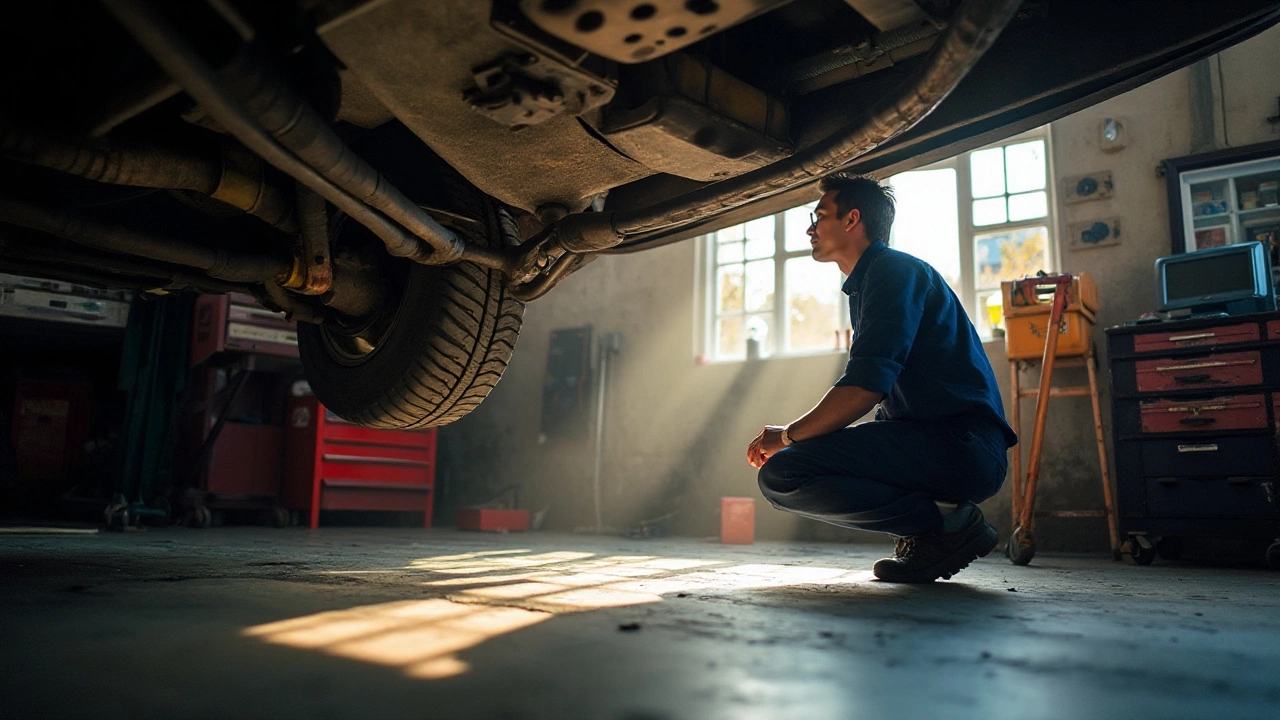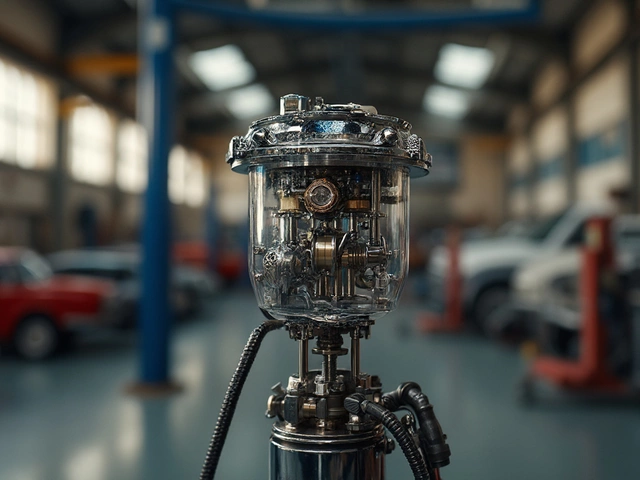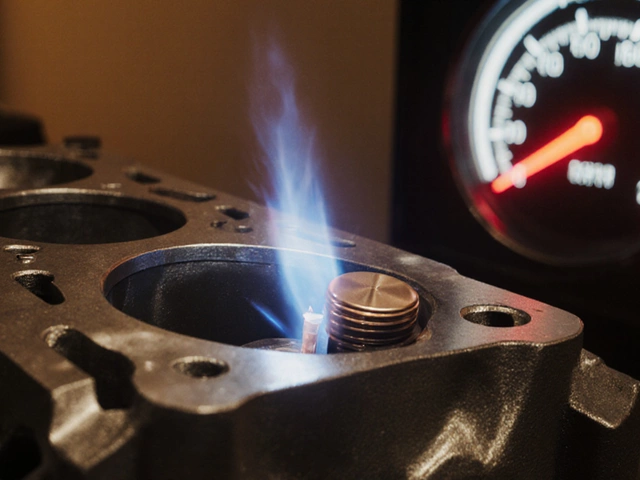Your car's suspension system is a silent warrior, ensuring that your journeys are smooth, even over the bumpiest terrains. It's responsible for handling and comfort, absorbing shock and maintaining tire traction. However, it doesn't take kindly to heavy impacts. Speed bumps taken too enthusiastically or sudden encounters with potholes can result in bending and damage.
So, how can you spot trouble lurking beneath your vehicle? A bent suspension often makes itself known through telltale signs. You might notice a peculiar wear pattern emerging on your tires or hear unsettling noises every time you turn or hit a bump. Sometimes, the car might pull to one side without your say-so. Recognizing these symptoms early is crucial to maintaining safety and performance.
Although we all love a good DIY project, suspension issues typically require professional attention. An accurate diagnosis and repair will prevent further deterioration and, ultimately, avoid costlier fixes. Paying close attention to your car's behavior and performing regular checks is wise. After all, a well-kept suspension ensures many more miles of comfortable adventures.
- Understanding Suspension Roles
- Detecting Common Symptoms
- Conducting a Visual Inspection
- Effects of a Bent Suspension
- When to Seek Professional Help
Understanding Suspension Roles
The suspension system in your car isn’t just some complex add-on brimming with engineering whimsy. It's a key player in the drama of cars that work, ensuring balance between the forces of motion and rest, keeping everything intact inside that comfy cab of yours — even when the road outside gets rough. The suspension's primary job is straightforward yet vital; it supports the weight of the vehicle while keeping the tires planted firmly on the ground, come rain or shine, pothole or no pothole. This is where tire traction comes into play, an often-underestimated factor that contributes to vehicle control and safety.
When you press the brake pedal, your suspension system jumps into action yet again, helping to distribute the weight evenly across all four wheels, avoiding the dreaded nose dive. And let's not forget how it parts the red seas of driving menace by smoothing out jolts and vibrations, giving passengers a serene ride. This balance is its gift, like a tightrope walker masterfully balancing on a rope mid-performance. Shock absorbers, struts, and springs are the main elements of suspension, working collectively on the sidelines to absorb the harshness of the road's surface.
Diving deep into these components, the springs bear a lot of responsibility, absorbing energy and providing cushioning when the road isn't as polite as it should be. Types of springs include coil, leaf, and torsion bar, each with specific applications and benefits. Meanwhile, struts combine the functionalities of the shock absorber and certain suspension parts into a single, efficient package. Not to be sidelined, shock absorbers control bounce and provide a smooth ride. An interesting stat: approximately 50% of all suspension issues are related to coil springs, often due to wear and tear from constant use, according to recent studies.
As vehicles evolved from horse-drawn carriages to the advanced machines of today, the suspension system saw numerous innovations. In today’s vehicles, whether sedans or SUVs, suspension designs have matured, incorporating electronic assists for superior ride comfort. The active suspension systems adjust each wheel on the fly, based on the driving conditions, promising a ride smoother than silk. As car enthusiasts may recall, legendary automotive engineer Ferdinand Porsche believed that, "A car should be light and agile, and precise suspension is where it begins." His insight holds true as modern manufacturers continuously refine these systems for better performance.
Understanding these fundamental roles gives you insight into how suspension issues can manifest and ripple out, affecting more than just the comfort of a ride. Recognizing symptoms early like a good detective and knowing when parts like shocks or struts require a second opinion, could mean the difference between a quick adjustment and a hefty repair bill down the line. So, the next time you hit the road, spare a thought for your car's humble suspension components — they are quite literally supporting you every mile of the way.
Detecting Common Symptoms
When it comes to identifying potential issues with your car's suspension, being alert to the symptoms is your first line of defense. A bent suspension often speaks in a language of its own, revealing its distress through changes in vehicle behavior and aesthetics. One of the earliest and most frequent indicators is uneven tire wear. Remember that your tires are on the frontline, absorbing all the impact a road throws at your car. When you notice that the tread is wearing out unevenly, it might not just be due to misalignment alone. Often, it signals deeper issues, hinting at your car's suspension parts like shock absorbers or struts suffering from excessive stress.
Another unmistakable sign is the appearance of unusual noises when driving over irregular surfaces or when making sharp turns. Cars aren't designed to creak and groan. If yours is starting to sound like an old attic door, listen closely. Such noises are often symptomatic of worn-out or damaged suspension components, and ignoring them can lead you down a costly road. "Check your suspension if strange noises persist," advises Tom Magliozzi, an experienced auto expert. "Noises tell you a story, don't shush them."
Vigilance is key when dealing with suspension issues. One should pay attention to any unexplained changes in how the steering wheel behaves. Is your vehicle pulling towards one side? The culprit might be a bent suspension component. Such a scenario can also be a precursor to other steering problem manifestations. Being proactive and getting a professional assessment at the earliest opportunity can save you from larger headaches and hefty repair bills down the line.
Finally, don't overlook changes in your vehicle's ride quality and visibility of physical damage. If the car feels overly bouncy or your daily commute feels as taxing as a roller coaster ride, it's time to get your vehicle's suspension looked at. Likewise, if you notice any bending or uncharacteristic shifts in the vehicle's stance, you may be dealing with a physically compromised suspension. To aid in understanding these symptoms better, consider the common suspension-related issues detailed in the table below.
| Symptom | Possible Cause |
|---|---|
| Uneven tire wear | Strut or shock absorber issue |
| Unusual noises | Worn suspension joints |
| Vehicle pulling to one side | Bent suspension arm |
| Excessive bounce or roll | Damaged shock absorbers |

Conducting a Visual Inspection
Visual inspections of your car's suspension can reveal a great deal about its health, especially if it's bent or damaged. Before you leap into action, ensure you've parked on a level, stable surface. Safety is paramount. Grab your flashlight and begin by taking a slow walk around your vehicle, paying close attention to where the wheels nestle up beneath the body. The goal here is to spot any glaring discrepancies, like a slumped side or a subtle tilt in posture. Uneven gaps between tires and fenders are early indicators of trouble brewing down below. Get down low, take your time, and don't be afraid to get your hands a little dirty.
Now, let's take a deeper dive under your ride. The suspension comprises several components, such as control arms, struts, and springs. It pays to be methodical. Look for signs like cracked bushings, rusty shocks, or suspicious oil leaks—these aren't casual blemishes. Instead, they often point to more significant wear and impending failure. Such symptoms demand attention, as a small irregularity can expedite the deterioration of your entire suspension system. Your eyes are your first line of defense, but don't deny your other senses. Tap the parts you'll visually inspect, listen for any hollow sounds—often a betrayal of internal corrosion.
Interestingly, bent suspensions often hide in their intricacy. In the twisting dance of metal and rubber, it's easy to overlook slight bends or warps. Therefore, it's wise to measure the distance between suspension elements and ensure they mirror manufacturer specifications. For instance, strut rods should harbor no bends, and their angles must remain true and unyielded. An accurate ruler might be your best ally here, illuminating deviations plain sight tends to miss.
Inspections become more enlightening if you have historical perspective. Consider keeping a maintenance log, maybe a small notebook in your glove compartment. Jot down tangible changes over time to capture any adjustments or replacements. Such data are invaluable. Remember these wise words from seasoned mechanic Phil Daniels:
"Neglecting tiny defects is like brushing off an approaching storm—you may regret it dearly."His words remind us of the delicate balance between observation and action. Using these records alongside visual inspections will provide a comprehensive picture of your car's past, present, and what its future may hold.
Ultimately, a bent suspension can cast a long shadow over your aspirations for smooth driving and achievable fuel efficiency. Address such issues promptly with professional assistance—the expense of vigilance is a modest price compared to the potential costs of neglect. By engaging in routine inspections and timely checks, you reduce stress and maintain peace on the road. With these efforts, you're not merely prolonging your vehicle's life; you're ensuring your safety and comfort remain paramount.
Effects of a Bent Suspension
When a bent suspension lurks beneath your car, it doesn't waste time announcing its presence in various, sometimes subtle, yet impactful ways. A compromised suspension system does more than just make your drive bumpy; it takes a toll on every aspect of your vehicle's performance. The most immediate effect is on your comfort and control. Think of it like trying to write with a crooked pen; the output isn't optimal, and the process just feels wrong. A bent suspension can significantly alter the vehicle's steering and handling characteristics, making it feel unsteady and unreliable. This instability can result in dangerous driving conditions, particularly on wet or uneven road surfaces.
Tire health is another critical area affected by suspension issues. Uneven tire wear is not just an annoyance; it's a costly consequence of a bent suspension. When your car's alignment is off due to the suspension, tires bear the brunt in the form of patchy wear patterns. Over time, this not only decreases tire life but also affects fuel efficiency and overall ride quality. Imagine watching your tires, which can easily set you back a few hundred dollars, disappear right before your eyes! As noted by the National Highway Traffic Safety Administration, "Tires are the only part of the vehicle that touch the road, so maintaining them in peak condition is paramount to safety.”
But the effects ripple beyond just the tires and handling. The strains of a bent suspension often lead to problems with the vehicle’s frame itself. If left unaddressed, these can grow into more serious structural damages. This is akin to ignoring a termite infestation in a wooden house—it might not seem a big deal initially, but over time, the damage becomes irreparable. The knock-on effect of a failing suspension can also extend to parts like brakes and axles. A suspension that's operating under a bent condition is under increased strain, leading to faster wear and potential failures in these critical components.
Finally, the safety of the vehicle occupants is always a significant concern. A well-functioning suspension system ensures that a car maintains optimal contact with the road surface, essential for traction and braking efficiency. A bent suspension could mean higher stopping distances, especially in emergency situations, which could be the difference between a close call and an accident. In the grand scheme of things, the suspension acts as the intermediary between the car and the road; its state directly influences how the car responds to our commands as drivers.
Looking at vehicle maintenance under a microscope often reveals the interconnected nature of car systems. When one element is off, it tends to breed trouble in neighboring areas. With suspension issues, particularly bending, the process is no different. Catching these issues early is not just beneficial—it's necessary. Frequent checks by a professional and paying heed to how your vehicle feels can mitigate these problems early on. Your wallet, and more importantly, your safety, will thank you.

When to Seek Professional Help
Car ownership brings its fair share of challenges, and understanding when to call in the experts is crucial. A bent suspension can manifest subtly at first, but as time marches on, the issues can amplify drastically. The moment you catch a weird noise or the steering feels off-kilter, it might be easy to dismiss as a minor hiccup. However, suspending disbelief about potential problems can cost both peace of mind and significant repairs down the road. Recognizing the early signs is only half the battle; knowing when a professional needs to step in is key.
Your suspicions should rise the minute you notice uneven tire wear. This unevenness suggests that your tires aren't making proper contact with the road. A professional mechanic can assess whether this is due to a bent suspension or another issue, and then realign or repair as needed. Think of it as ensuring your car's feet are positioned correctly. Besides, the money you'll save on tire replacements just by solving the root cause will be worth the visit.
It's not merely aesthetic when your vehicle seems to sag or tilt to one side more than the other. A visual check might reveal a contributing factor, yet there could be underlying problems requiring diagnostic equipment and skilled hands. Professional mechanics use specialized tools – which aren't typically affordable or practical for weekend warriors – to identify and correct the real misalignments. Regular maintenance checks, particularly after taking an especially hard blow to your wheels, keep such sagging from becoming an expensive ordeal.
The sounds that a trusted mechanic hears when tinkering under the hood might not mean much to the untrained ear. However, clunks, knocks, and creaks as you make your daily drive are not just for added background noise. A professional knows the difference between normal operational sounds and those indicating a potentially bent suspension. These sounds might point to worn or failing components that can contribute to larger suspension damage if left unchecked, like your car's way of issuing a distress signal.
"Regular vehicle check-ups are as vital as regular health check-ups. After all, a well-maintained car significantly reduces the risk of unexpected failures," says Jack Thompson from the Automotive Research Institute.
Let's not forget that persistent steering issues require immediate attention. If your car veers off to one side without your guidance, it may suggest serious suspension misalignment, demanding prompt corrective action. When steering problems become part of every drive, it's time to have it checked by someone with experience. Comparatively, correcting automatic steering pulls now can prevent accidents later.
Ultimately, when attempting any repairs, safety and precision should reign supreme. An expert's hands bring not only the skill to restore your vehicle but also the reassurance of properly completed work. By leaning on their expertise, you're ensuring the long-term health of your vehicle's suspension and enjoying safer travels.






